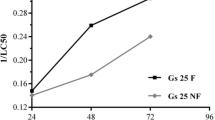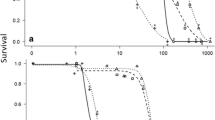Abstract.
The effects of the insecticides Guthion (technical grade) and Guthion 2S (commercial formulation) on survival and growth of tadpoles of the Pacific treefrog Pseudacris regilla, and larvae of the Northwestern salamander Ambystoma gracile and the spotted salamander Ambystoma maculatum were determined in continuous-flow exposures in the laboratory. Ninety-six–hour LC50 values were >3.6 mg/L for P. regilla with technical grade Guthion and 1.47 mg/L with the formulation Guthion 2S (measured as active ingredient Guthion). Ten-day LOAEL and NOAEL values based on length and weight for P. regilla with Guthion were 3.60 and 0.98 mg/L. LOAEL and NOAEL values based on length and weight for P. regilla with Guthion 2S were 0.17 and 0.07 mg/L. The 96-h LC50 for Guthion 2S was 1.67 and 1.90 mg/L for A. gracile and A. maculatum, respectively. LOAEL and NOAEL values based on length and weight for A. gracile with Guthion 2S were 0.22 and 0.10 mg/L; they were 0.11 and 0.03 mg/L for A. maculatum based on weight. These species are as similar in sensitivity as some fish species but are more tolerant to Guthion than most invertebrates.
Similar content being viewed by others
Author information
Authors and Affiliations
Additional information
Received: 6 July 1997/Accepted: 14 November 1997
Rights and permissions
About this article
Cite this article
Nebeker, A., Schuytema, G., Griffis, W. et al. Impact of Guthion on Survival and Growth of the Frog Pseudacris regilla and the Salamanders Ambystoma gracile and Ambystoma maculatum . Arch. Environ. Contam. Toxicol. 35, 48–51 (1998). https://doi.org/10.1007/s002449900347
Issue Date:
DOI: https://doi.org/10.1007/s002449900347




